About Chungnam
News
Towns Where People Can Take a Rest The Slow City, Yesan
2010.01.14(목) | CNnews (![]() chungnamdo@korea.kr)
chungnamdo@korea.kr)
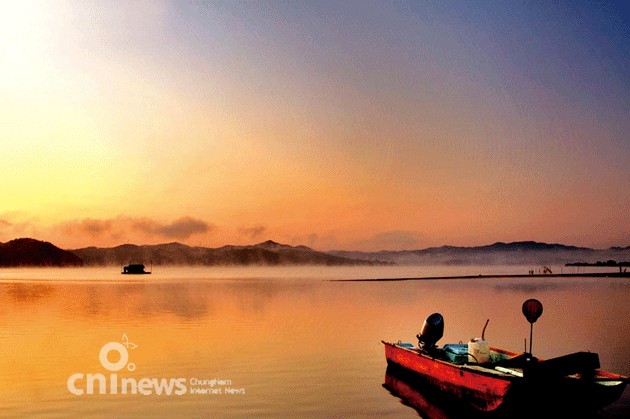 |
||
| ▲ Yesan boasts great harmony among water, the mountains, and plains as they are. The city builds artificial facilities to the minimum, realizing the importance of the environment. | ||
Diverse Human-Oriented Tourist Resources
On September 4, 2009, Yesan-gun of Chungnam was certified as the world’s 121st and the nation’s sixth slow city by the presidential committee of the International Federation of Slow Cities. Yesan-gu boasts splendid nature and rich culture and history; the Yedang Reservoir is famous among anglers for its beautiful scenery and rich game, the Daeheung Hyanggyo is a Confucian educational agency set up in early Chosun, and the Daeheung zelkova tree is more than 1,000 years old.
Yesan is also renowned for its high quality slow foods including apples, rice produced from the fertile Yedang plain, fish soup made from freshwater fish from Yedang Reservoir, and steamed crucian carps.
It’s also the background of the old, famous story about brotherhood and the value of sharing, which is introduced in an elementary textbook. The locals have issued monthly newsletters to inherit Yesan’s traditional culture and heritage and thus received high points for them from the International Federation of Slow Cities.
While keeping its country atmosphere, it pursues harmony between man and nature through environmental preservation instead of reckless development and promotes the experiences of traditional culture through cultural relics and artifacts. Its major tourist resources include the Sudeok Buddhist Temple, the house of Kim Jeong-hee, Korea’s greatest calligrapher, Deoksan Spa, Korea’s only sodium spa, and the beautiful Mt. Gaya and Deoksung.
Yedang Reservoir, the Mecca of Fishing
Known as the best spot for fishing fresh water fish, the reservoir is the largest in the nation. Last year about 84,000 anglers visited it and enjoyed fishing.
There are about 50 restaurants around the reservoir, offering their unique and delicious dishes. In addition, Yesan-gun runs the sculpture park, ecological park, and a small resting place. Along the edge of the reservoir, there are many pensions and motels for tourists to relax. The reservoir is the heavenly destination for anglers and the ideal driving course for couples.
Having diverse kinds of fish, the reservoir is famous among general tourists as well as anglers. The 50 or so restaurants around it offer such unique and delicious dishes as steamed crucian carps, fish soup, beef ribs, broiled small intestines, and herbs. The locals are sure to offer those five major dishes to tourists without hesitation.
There are many attractions around the reservoir including the octagonal pavilion, the sculpture park, the quiet and still Sudeok Buddhist Temple, the old house of Chusa Kim Jeong-hee, the great calligrapher, and Deoksan Spa where you can rest your exhausted body from all the sightseeing.
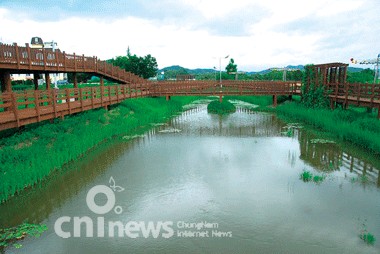 |
||
| ▲ Lake Yedang is Korea's biggest artificial freshwater lake and presents a vast and solitary landscape. The fishing boats float leisurely, waiting for those who visit the lake for peaceful moments in life. | ||
Yedang Tourist Destination and Yedang Reservoir Ecological Park
The Yedang Tourist Destination covering 140,000㎡ around the Yedang Reservoir is equipped with all sorts of convenience facilities along with the outdoor stage, fountain, sculpture park, camp site, resting place, and promenade for families to enjoy. It holds Yesan-gun’s Old Stories Festival. The Ecological Park of Yedang Reservoir also has the 500m underwater promenade and an observatory. With an iris and lotus flower complex established recently, it has emerged as a new tourist attraction.
Gwangshi Korean Beef Cattle Village, the Heaven of Korean Beef
There is a country village around both sides of Local Road No. 619 of Yesan-gun. The village holds a concentration of 24 butcher shops that only deal with beef from Korean cows and also sell dishes made from it. It started with 15 of them 15 years ago. As their businesses grew, the village was formed and grew as well. They raise Korean cows only with environment-friendly feeds before they slaughter and sell the beef, which is light red, bright, and glossy. With fat distributed evenly, the beef tastes soft and heavenly and thus enjoys huge great word of mouth.
Sudeok Buddhist Temple, One of Korea’s Great Buddhist Temples
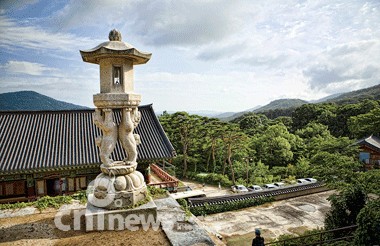
▲ here is an observatory space over Sudeok Buddhist Temple to appreciate Mt. Deokseung.
One can’t think of Yesan without recalling the Sudeok Buddhist Temple. Sitting in the beautiful scenery of Mt. Deoksung, it is one of Korea’s oldest Buddhist temples. Set up in the reign of King Wideok (554~597) in Baekje, it is the only remaining Baekje Buddhist temple and keeps the traces of the high priest.
It holds National Treasure No. 49, which is the main temple. Built in 1308 in Goryeo, it looks unbalanced at first glance but in fact hides the most advanced scientific architecture of our ancestors.
The wooden structure has three rooms in the front and four in the side. With the bottom of the pillars revealed outside, it boasts the highest beauty and a gorgeous formative charm.
House of Chusa and Memorial Hall
The house was the birth place of Chusa Kim Jeong-hee and covers 300㎡. It’s in the typical style of a traditional nobleman’s house in Chosun. One of the great realists and calligraphers in late Chosun, Kim Jeong-hee created his own Chusa style of calligraphy and enjoys a great reputation as Korea’s utmost calligrapher.
Founded in 2008, the Chusa Memorial Hall presents a well-kept history of the calligrapher from his birth to the creation of the Chusa style. Holding his “Sehando,” a National Treasure, and his writings by the period, it is a good place to see the entire collection of his works.
Deoksan Spa and Its Myth
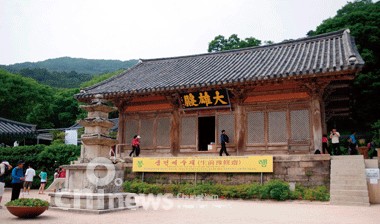
▲ The main building of Sudeok Buddhist Temple, part of the essential sight-seeing route.
With a spa history of 500 years, Deoksan Spa began with a mysterious origin. The myth tells of a crane with a broken leg that one day landed here and treated its wound with the water. After it departed, people saw the spot and found a warm and soft spring pumping up water.
With its opening as a spa in 1917, Deoksan Spa offers spa water of 45℃ or higher containing germanium. The water is known to help treat muscle and joint pain and neuralgia, promote blood circulation and facilitate cell regeneration, being recognized as the nation’s best spa water. There are about 50 accommodations including seven spa sites, two tourist hotels, one general hotel, and one condominium, as well as various kinds of restaurants and convenience facilities.
Deoksan Spa Castle, a Place for Waterside Excursions and Spa During All Seasons
Located 1 hour and 20 minutes from Seoul, Deoksan Spa Castle combines the spa and the water park experiences together and has enjoyed popularity as a new experiential tourist destination. Its water of 49℃ of higher contains 43 elements including germanium. The spa pumps up to 3,800 tons of alkali spa water every day.
Deoksan Spa Castle offers a wide variety of spas including the Bade pool where you can enjoy 29 different kinds of water pressure massage for all the parts of the body, the room of yellow earth and charcoal where one can enjoy the sauna, the “European Spa” where you’re treated as a Roman empress or goddess in the gorgeous setting, and the outdoor spa. Jump in the pool with rapid currents armed with a life vest and tube, and you will feel like you’re in the sea.
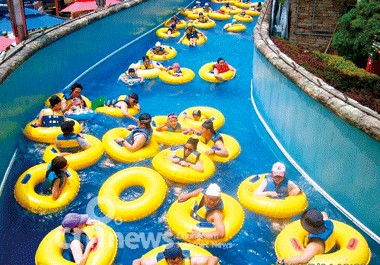 |
||
| ▲ The Spa Castle is heaven for resting and water play year round. Combined with Yesan's clean natural environment, foods, and traditional culture, it today attracts more attention than ever before. | ||
There are also spas of Korean themes such as the spa of apple wine and the spa of doctor fish. Smelling the scent of apple wine in the spa of doctor fish, you can have your corneous tissues taken care of by the fish and relax.
There are also spas for those who want some quiet: the romantic spa is for couples, the classic spa is for a half-length bath in classical music, and the jazz spa is for mud treatment for good skin.
There is a herb and sculpture park outside the Deoksan Spa Castle. Walking along the pretty promenade, you will feel a sense of leisure and comfort that’s hard to have in the city. Group visitors can enjoy sports at the basketball and badminton court. Don’t forget to relieve your physical and mental stress with yoga, hypnosis, and mental therapy at the music therapy room and have your entire body treated at the East Asian style vital therapy.
Picking Apples at the Yesan Tourist Farm
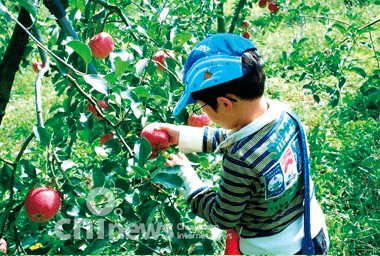
▲ Visitors can pick apples at one of the farms on the farm stay program for families. During harvest times, the farms are replete with families that enjoy farm experiences and laugh with joy.
Yesan is famous for its apples as well. Driving along the roads, you will see farms that grow delicious apples with solid flesh everywhere. If you have children to entertain, picking sweet and delicious apples is recommended. Yesan apples enjoy a great reputation for their high sugar content and crispy flesh.
During the experience, you will first choose a box that fits the amount of apples you’ll pick and devote yourself to picking red apples while listening to the farmer’s explanations. He will inform you of how to grow and pick good apples.
Apply for the apple picking event at the homepage of Yesan-gun from September to November when apples are harvested and check the schedule.




